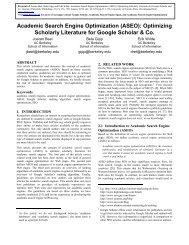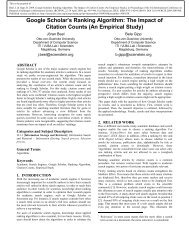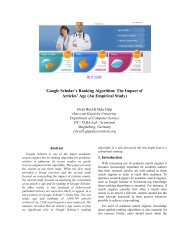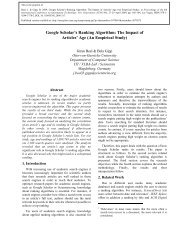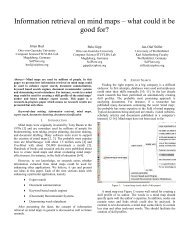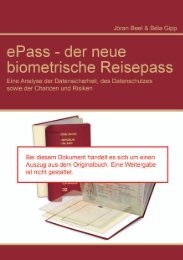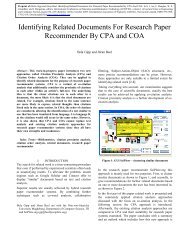Link Analysis in Mind Maps: A New Approach to ... - SciPlore
Link Analysis in Mind Maps: A New Approach to ... - SciPlore
Link Analysis in Mind Maps: A New Approach to ... - SciPlore
You also want an ePaper? Increase the reach of your titles
YUMPU automatically turns print PDFs into web optimized ePapers that Google loves.
Prepr<strong>in</strong>t of: Jöran Beel and Bela Gipp. <strong>L<strong>in</strong>k</strong> <strong>Analysis</strong> <strong>in</strong> M<strong>in</strong>d <strong>Maps</strong>: A <strong>New</strong> <strong>Approach</strong> To Determ<strong>in</strong>e Document Relatedness. In Proceed<strong>in</strong>gs of the FourthInternational Conference on Ubiqui<strong>to</strong>us Information Management and Communication (ICUIMC’10). ACM, January 2010. Downloaded fromhttp://www.sciplore.org<strong>L<strong>in</strong>k</strong> <strong>Analysis</strong> <strong>in</strong> M<strong>in</strong>d <strong>Maps</strong>: A <strong>New</strong> <strong>Approach</strong> <strong>to</strong>Determ<strong>in</strong><strong>in</strong>g Document RelatednessJöran BeelOt<strong>to</strong>-von-Guericke UniversityFIN / ITI / VLBA-LabGermanybeel@sciplore.orgBela GippOt<strong>to</strong>-von-Guericke UniversityFIN / ITI / VLBA-LabGermanygipp@sciplore.orgABSTRACTIn a previous paper we presented various ideas on how<strong>in</strong>formation retrieval on m<strong>in</strong>d maps could enhance applicationssuch as expert systems, search eng<strong>in</strong>es and recommendersystems. In this paper we present the first research results. In abrief experiment we researched l<strong>in</strong>k analysis respectively citationanalysis, if applied <strong>to</strong> m<strong>in</strong>d maps, is suitable <strong>to</strong> calculatedocument relatedness. The basic idea is that if two documents Aand B are l<strong>in</strong>ked by the same m<strong>in</strong>d map, these documents arelikely <strong>to</strong> be related. This <strong>in</strong>formation could be used by itembaseddocument recommender systems. In the example,document B could be recommended <strong>to</strong> those users <strong>in</strong>terested <strong>in</strong>document A. In addition, we propose that those documents l<strong>in</strong>ked<strong>in</strong> high proximity with<strong>in</strong> a m<strong>in</strong>d map are more closely relatedthan those documents l<strong>in</strong>ked <strong>in</strong> lower proximity. The results ofour experiment support our ideas. It seems that l<strong>in</strong>k analysisapplied <strong>to</strong> m<strong>in</strong>d maps can be used for determ<strong>in</strong><strong>in</strong>g therelatedness of documents and therefore for improv<strong>in</strong>g documentrecommender systems.Categories and Subject Descrip<strong>to</strong>rsH.3.3 [Information S<strong>to</strong>rage and Retrieval]: Information Searchand Retrieval – <strong>in</strong>formation filter<strong>in</strong>g, retrieval models, searchprocessH.3.7 [Information S<strong>to</strong>rage and Retrieval]: Digital Libraries –system issues, user issuesGeneral TermsAlgorithms, Measurement, Documentation.Keywordsm<strong>in</strong>d maps, recommender systems, research paper recommender,document recommender, metrics, citation analysis, l<strong>in</strong>k analysisPermission <strong>to</strong> make digital or hard copies of all or part of this work forpersonal or classroom use is granted without fee provided that copies arenot made or distributed for profit or commercial advantage and that copiesbear this notice and the full citation on the first page. To copy otherwise, orrepublish, <strong>to</strong> post on servers or <strong>to</strong> redistribute <strong>to</strong> lists, requires prior specificpermission and/or a fee.Proceed<strong>in</strong>gs of the 4th International Conference on Ubiqui<strong>to</strong>usInformation Management and Communication’10, January 14–15, 2010,Suwon, Korea.Copyright 2010 ACM, ISBN 978-1-60558-893-31. INTRODUCTIONM<strong>in</strong>d mapp<strong>in</strong>g is a common method <strong>to</strong> structure and visualizeideas, manage electronic literature and <strong>to</strong> draft documents. Someusers do l<strong>in</strong>k <strong>in</strong> their m<strong>in</strong>d map <strong>to</strong> external documents such asPDFs or websites. Some even cite scholarly literature, for<strong>in</strong>stance by add<strong>in</strong>g BibTeX keys <strong>to</strong> a m<strong>in</strong>d map’s node (seeFigure 1 for an example). In a recent paper we proposed <strong>to</strong>analyze these l<strong>in</strong>ks and references <strong>to</strong> determ<strong>in</strong>e the relatedness ofthose documents that are l<strong>in</strong>ked <strong>in</strong> the m<strong>in</strong>d map [1] 1 .The basic idea is that two documents are related if they are bothl<strong>in</strong>ked by a m<strong>in</strong>d map. In addition, it was assumed that the closerthe l<strong>in</strong>ks occur <strong>in</strong> the m<strong>in</strong>d map, the higher related the l<strong>in</strong>keddocuments are. If the assumption proves <strong>to</strong> be right, <strong>L<strong>in</strong>k</strong><strong>Analysis</strong> <strong>in</strong> M<strong>in</strong>d <strong>Maps</strong> (LAMM) could be used <strong>to</strong> enhancesearch eng<strong>in</strong>es and document recommender systems s<strong>in</strong>ce thesesystems often present related documents <strong>to</strong> their users.We conducted a brief experiment <strong>to</strong> test the proposed idea andpresent the results <strong>in</strong> this paper. The focus of this paper lies oncalculat<strong>in</strong>g the relatedness of scholarly literature and onenhanc<strong>in</strong>g research paper recommender systems as we plan <strong>to</strong><strong>in</strong>tegrate LAMM <strong>in</strong><strong>to</strong> our academic search eng<strong>in</strong>e and researchpaper recommender system <strong>SciPlore</strong> 2 . However, it's highlyprobable that the results would be similar for other k<strong>in</strong>d ofdocuments l<strong>in</strong>ked by a m<strong>in</strong>d map such as websites.In the next section, related work about research paperrecommender systems and citation analysis is presented. It isthen followed by a section show<strong>in</strong>g the methodology which hasbeen used <strong>to</strong> evaluate LAMM. F<strong>in</strong>ally, the results, a discussion,and an outlook <strong>to</strong>wards future work conclude.2. RELATED WORKSeveral attempts have been made <strong>to</strong> establish research paperrecommender systems [2-7]. Some of them use citation analysis<strong>to</strong> determ<strong>in</strong>e the degree of relatedness between two papers. Anoverview of different citation analysis approaches fordeterm<strong>in</strong><strong>in</strong>g the relatedness of research papers is given <strong>in</strong> [8]. At1 In this paper we do not dist<strong>in</strong>guish between l<strong>in</strong>k<strong>in</strong>g files andreferenc<strong>in</strong>g scholarly literature, for <strong>in</strong>stance with a BibTeXkey. Citations, l<strong>in</strong>ks <strong>to</strong> files on the user’s hard drive andhyperl<strong>in</strong>ks <strong>to</strong> websites are all considered as ‘l<strong>in</strong>k’.2 http://www.sciplore.org
Figure 1: M<strong>in</strong>d map draft of a paper (arrows <strong>in</strong>dicate a l<strong>in</strong>k <strong>to</strong> a PDF file; the <strong>to</strong>oltip displays a BibTeX key)this time, our research focuses on co-citation analysis [9] and itsextension citation proximity analysis [10].Accord<strong>in</strong>g <strong>to</strong> co-citation analysis, two papers A and B are relatedif a third paper C references both. If more than one paperreference paper A and B <strong>to</strong>gether, their relatedness is supposed<strong>to</strong> be even higher. Citation proximity analysis additionallyconsiders the location of citations <strong>in</strong> the full text: Two papers Aand B are supposed <strong>to</strong> be more highly related when they areclosely referenced by a third paper C <strong>in</strong> the text. For <strong>in</strong>stance, ifpaper C references paper A and B <strong>in</strong> the same sentence, A and Bare likely <strong>to</strong> be highly related. If paper C references paper A <strong>in</strong>the beg<strong>in</strong>n<strong>in</strong>g of a 100-page document and paper B at the end,their relatedness is probably not nearly as high.Co-citation analysis and citation proximity analysis can be usedby research paper recommender systems <strong>to</strong> make item-basedrecommendations: If paper A and B are related, paper B may berecommended <strong>to</strong> those users <strong>in</strong>terested <strong>in</strong> paper A (but notknow<strong>in</strong>g paper B yet).However, co-citation analysis and citation proximity analysishave <strong>to</strong> cope with some drawbacks.1. Availability of Data: Co-citation analysis and citationproximity analysis cannot be applied <strong>to</strong> all researchpapers due <strong>to</strong> a lack of (correct) data [11, 12]: manyresearch papers are not cited at all; citation databasessuch as ISI Web of Knowledge do not cover allavailable publications; and due <strong>to</strong> technical difficulties,citations are not always recognized correctly, which <strong>in</strong>turn leads <strong>to</strong> <strong>in</strong>correct data <strong>in</strong> citation databases.2. Robustness of Data: Citations are often considered asbiased because authors do cite papers they should notcite and do not cite papers they should cite [12].Accord<strong>in</strong>gly, citation based recommender systemsmight provide irrelevant recommendations.3. Timel<strong>in</strong>ess of Data: Publish<strong>in</strong>g scientific articles is aslow process and it takes months or even years beforethey are published and citations are received.Accord<strong>in</strong>gly, documents recommended based oncitation analysis are, at the very least, several monthsold.4. Metrics: There exist metrics for measur<strong>in</strong>g therelatedness of research papers based on citationanalysis (for <strong>in</strong>stance, coupl<strong>in</strong>g strength [13] or thecitation proximity <strong>in</strong>dex [10]). However, <strong>to</strong> ourknowledge, each metric focuses solely on one citationanalysis approach and no comb<strong>in</strong><strong>in</strong>g metric exists yet.Consequently, relatedness of research papers based oncitations cannot be measured and expressed thoroughly.Summarized, citation analysis applied <strong>to</strong> scholarly literature cando a good job <strong>in</strong> identify<strong>in</strong>g related articles, but there is room forimprovement.3. METHODOLOGYOur <strong>in</strong>tention was <strong>to</strong> conduct an experiment <strong>to</strong> obta<strong>in</strong> first<strong>in</strong>dications if <strong>L<strong>in</strong>k</strong> <strong>Analysis</strong> <strong>in</strong> M<strong>in</strong>d <strong>Maps</strong> (LAMM) might besuitable for determ<strong>in</strong><strong>in</strong>g research paper relatedness. Twoassumptions were researched:1. Two research papers A and B are related if at least onem<strong>in</strong>d map l<strong>in</strong>ks them both2. Two research papers A and B are more highly relatedthe more closely they are l<strong>in</strong>ked with<strong>in</strong> a m<strong>in</strong>d mapAs part of the experiment, five m<strong>in</strong>d maps were analyzed whichwere orig<strong>in</strong>ally created for draft<strong>in</strong>g research papers, respectivelyMasters Theses 3 . That means each of the m<strong>in</strong>d maps l<strong>in</strong>ks atleast <strong>to</strong> a few PDF files represent<strong>in</strong>g academic articles. Fromeach m<strong>in</strong>d map, l<strong>in</strong>ks (respectively citations) <strong>to</strong> three articleswere extracted and pairs were built (see Figure 2 forillustration). The first pair was built from the first and secondl<strong>in</strong>k <strong>in</strong> a m<strong>in</strong>d map. S<strong>in</strong>ce the distance between them was low,we expected this pair <strong>to</strong> be ‘highly related’. The second pair wasbuilt from the first and last l<strong>in</strong>k <strong>in</strong> the m<strong>in</strong>d maps. Here, thedistance between the l<strong>in</strong>ks was high. Accord<strong>in</strong>gly, we expectedthe correspond<strong>in</strong>g articles <strong>to</strong> be less closely related.3 Two m<strong>in</strong>d maps represented drafts of our own papers and threem<strong>in</strong>d maps were created by some of our students for theirMasters’ theses.
Relatedness (1=None; 5=Very High)To test our assumptions, titles and abstracts of the l<strong>in</strong>ked PDFswere extracted. S<strong>in</strong>ce five m<strong>in</strong>d maps were analyzed, five pairswith low distance (expected relatedness = (very) high) and fivepairs with high distance (expected relatedness =low) existed. Inaddition, five ‘control pairs’ of papers were created. We createdthese pairs <strong>in</strong> a way that they should appear as not be<strong>in</strong>g related<strong>to</strong> each other at all 4 .Some outliers exist: On average, pair 2 <strong>in</strong> m<strong>in</strong>d map 2 wasconsidered higher related than pair 1 <strong>in</strong> m<strong>in</strong>d map 2. In addition,pair 2 of m<strong>in</strong>d map 3 and pair 1 of m<strong>in</strong>d map 5 were rated asalmost not related. However, this is not surpris<strong>in</strong>g s<strong>in</strong>ce m<strong>in</strong>dmaps are usually used for draft<strong>in</strong>g a paper and thereforevariances are <strong>to</strong> be expected.Node5RootNodeNodeNodeNodeNode with l<strong>in</strong>k <strong>to</strong>PDFNode with l<strong>in</strong>k <strong>to</strong>PDFNodeNodeNode with l<strong>in</strong>k <strong>to</strong>PDF.........Node with l<strong>in</strong>k <strong>to</strong>PDFNode with l<strong>in</strong>k <strong>to</strong>PDFNodeNode with l<strong>in</strong>k <strong>to</strong>PDFPair 2 (ExpectedRelatedness: Low)Pair 1 (ExpectedRelatedness: High)Figure 2: <strong>L<strong>in</strong>k</strong> Extraction from the M<strong>in</strong>d <strong>Maps</strong> (Illustration)To build a pair of papers with a potentially high relatedness, the very first and thesecond l<strong>in</strong>k of a m<strong>in</strong>d map were taken, so the proximity between the two papers washigh. To obta<strong>in</strong> a pair of papers with rather low relatedness, the very first and the verylast l<strong>in</strong>k of a m<strong>in</strong>d map were taken.All pairs were shown <strong>to</strong> five participants 5 and the participantshad <strong>to</strong> rate the relatedness of the pairs on a scale from 1 <strong>to</strong> 5(1 = not related, 5 = highly related) . For evaluation, rat<strong>in</strong>gs werepa<strong>in</strong>ted <strong>in</strong> a scatter plot for each participant as well as the overallrat<strong>in</strong>g (mean and median). A more detailed statistical analysiswas not considered necessary, s<strong>in</strong>ce the graphs showed quiteclear results and the amount of data was <strong>to</strong>o little for extensivestatistic analyses.4. RESULTSFigure 3 shows the results. On average (mean), those pairsl<strong>in</strong>ked closely <strong>to</strong>gether <strong>in</strong> the m<strong>in</strong>d maps were consideredsignificantly more often (highly) related than those pairs notl<strong>in</strong>ked closely <strong>to</strong>gether. The control pairs, which were not l<strong>in</strong>kedby any m<strong>in</strong>d map, were all rated as not related, on average.4 The papers were taken from the <strong>SciPlore</strong> database, were notl<strong>in</strong>ked by any of the m<strong>in</strong>d maps and did not cite each other.5 None of the participants were <strong>in</strong>volved <strong>in</strong> creat<strong>in</strong>g the m<strong>in</strong>dmaps. The pairs of papers were distributed <strong>to</strong> the participantswithout their knowledge of the pairs be<strong>in</strong>g l<strong>in</strong>ked by a m<strong>in</strong>d mapor not. Each participant was shown all 15 pairs at once.43211 2 3 4 5M<strong>in</strong>d MapPair 1 - ExpectedRelatedness: (Very) HighPair 2 - ExpectedRelatedness: LowControl - ExpectedRelatedness: NoneFigure 3: Relatedness of Pairs <strong>in</strong> M<strong>in</strong>d <strong>Maps</strong> (Mean)5. DISCUSSIONOverall, the results are a first <strong>in</strong>dication that m<strong>in</strong>d maps can beused <strong>to</strong> calculate research papers’ relatedness. However, it needs<strong>to</strong> be emphasized that all five m<strong>in</strong>d maps were created by ourstudents and ourselves and hence came from the same ‘school ofthought’. It's very possible that other researchers use m<strong>in</strong>d maps<strong>in</strong> a different way, which would then lead <strong>to</strong> variations <strong>in</strong> theresults.In addition, similar problems as for classic ciation analysis are <strong>to</strong>be expected for <strong>L<strong>in</strong>k</strong> <strong>Analysis</strong> <strong>in</strong> M<strong>in</strong>d <strong>Maps</strong>. These problems arerelated <strong>to</strong> data availability, robustness, timel<strong>in</strong>ess and metricsand are discussed <strong>in</strong> the follow<strong>in</strong>g sections.5.1 Availability of DataData availability seems <strong>to</strong> be the ma<strong>in</strong> challenge LAMM willhave <strong>to</strong> face. It is unknown how many researchers use m<strong>in</strong>d mapsand how many are will<strong>in</strong>g <strong>to</strong> share their data. It could be that thenumber is rather low. Nevertheless, m<strong>in</strong>d mapp<strong>in</strong>g is a popularapplication. For <strong>in</strong>stance, the m<strong>in</strong>d mapp<strong>in</strong>g <strong>to</strong>ol FreeM<strong>in</strong>d isdownloaded over a 150,000 times a month [14], more than 1.5million people use M<strong>in</strong>dManager [15] and there exist dozens of<strong>to</strong>ols more [16, 17]. Even platforms for shar<strong>in</strong>g m<strong>in</strong>d maps existalready 6 . On our website sciplore.org we also offer a specialm<strong>in</strong>d mapp<strong>in</strong>g software for researchers which will enable us <strong>to</strong>collect m<strong>in</strong>d maps [18].Overall, we are confident, that sufficient data can be collectedthat makes LAMM worth research<strong>in</strong>g. Certa<strong>in</strong>ly, it will neverreplace citation analysis <strong>in</strong> scholarly literature or hyperl<strong>in</strong>kanalysis on websites but LAMM could serve as a complement forboth.6 For <strong>in</strong>stance, http://www.mappio.com, http://share.xm<strong>in</strong>d.net,and http://www.m<strong>in</strong>dmeister.com/maps/public/
Technical problems (<strong>in</strong> terms of identify<strong>in</strong>g references) should beequal or even less for LAMM than for classic citation analysis. Ifusers l<strong>in</strong>k <strong>to</strong> a unique identifier such as a BibTeX key, thecorrespond<strong>in</strong>g metadata should be easily extractable from theuser’s bibliographic database. If the user l<strong>in</strong>ks a PDF file, atleast the title should be easily identifiable from the PDF, <strong>in</strong> mostcases 7 .5.2 Robustness of DataAll social media platforms do have <strong>to</strong> cope with spam and fraudas soon as they become successful. There is no reason <strong>to</strong> assumethis would be different if m<strong>in</strong>d maps were used for calculat<strong>in</strong>grelatedness of documents. However, most social media platformsalso f<strong>in</strong>d a way <strong>to</strong> cope with fraud and spam. If only m<strong>in</strong>d mapsof ‘trusted’ users were used, serious spam and fraud couldprobably be prevented successfully. Trustworth<strong>in</strong>ess of usersprobably could be determ<strong>in</strong>ed <strong>in</strong> cooperation with socialnetworks, other community websites or by usage data of m<strong>in</strong>dmapp<strong>in</strong>g software.5.3 Timel<strong>in</strong>ess of DataWith LAMM, timel<strong>in</strong>ess has a clear advantage over classiccitation analysis. M<strong>in</strong>d maps do not need <strong>to</strong> be published <strong>in</strong>journals or at conferences. They could be analyzed the momentthey are created. This would enable research paper recommendersystems <strong>to</strong> recommend new publications faster than with classiccitation based approaches.5.4 Appropriate MetricsLAMM could use the same metrics that are used for citationanalysis. Perhaps slight modifications would have <strong>to</strong> be made,but overall, metrics should be very similar (and so theadvantages and disadvantages of citation based metrics).6. SUMMARY & FUTURE RESEARCHIn this paper we presented <strong>L<strong>in</strong>k</strong> <strong>Analysis</strong> <strong>in</strong> M<strong>in</strong>d <strong>Maps</strong>(LAMM). LAMM is an approach for determ<strong>in</strong><strong>in</strong>g the relatednessof documents by apply<strong>in</strong>g methods from hyperl<strong>in</strong>k and citationanalysis <strong>to</strong> m<strong>in</strong>d maps. The basic idea is: If two documents A andB are l<strong>in</strong>ked or referenced by a m<strong>in</strong>d map, these articles arelikely <strong>to</strong> be related. Consequently, a recommender system couldrecommend document B <strong>to</strong> those users lik<strong>in</strong>g document A. Inaddition, we proposed that two documents are higher relatedwhen their proximity <strong>in</strong> the m<strong>in</strong>d map is higher. In a small study(five m<strong>in</strong>d maps and five participants) we obta<strong>in</strong>ed first<strong>in</strong>dications that our assumptions could be true. The participantsrated research articles that were l<strong>in</strong>ked <strong>in</strong> high proximity <strong>in</strong> them<strong>in</strong>d map, as more highly related than those articles l<strong>in</strong>kedwith<strong>in</strong> low proximity. Advantages and problems of LAMM <strong>in</strong>comparison <strong>to</strong> classic citation analysis were also discussed <strong>in</strong> thispaper. Especially <strong>in</strong> respect <strong>to</strong> timel<strong>in</strong>ess, MMCA seems likely<strong>to</strong> outperform classic citation analysis. On the other hand, dataavailability is likely <strong>to</strong> be a much larger problem than it is forcitation analysis.Overall, LAMM might prove <strong>to</strong> be a promis<strong>in</strong>g field of researchhav<strong>in</strong>g the chance <strong>to</strong> complement classic citation analysis andenhance research paper recommender systems <strong>in</strong> the long run.However, there is a need for more research s<strong>in</strong>ce many questionsrema<strong>in</strong> unanswered:How many researchers are us<strong>in</strong>g m<strong>in</strong>d maps?How many are will<strong>in</strong>g <strong>to</strong> share them?How can spam and fraud be prevented?Which metrics should be used <strong>to</strong> measure relatedness?How should these metrics be comb<strong>in</strong>ed with exist<strong>in</strong>gones based on citations and other techniques (for<strong>in</strong>stance, based on text m<strong>in</strong><strong>in</strong>g and collaborativefilter<strong>in</strong>g)?While this paper focuses on determ<strong>in</strong><strong>in</strong>g relatedness of scholarlyliterature, LAMM could be applied equally well <strong>to</strong> otherdocument types such as web pages.7. REFERENCES[1] Jöran Beel, Bela Gipp, and Jan Olaf Stiller. InformationRetrieval on M<strong>in</strong>d <strong>Maps</strong> – What could it be good for? InProceed<strong>in</strong>gs of the 5th International Conference onCollaborative Comput<strong>in</strong>g: Network<strong>in</strong>g, Applications andWorkshar<strong>in</strong>g (CollaborateCom’09), Wash<strong>in</strong>g<strong>to</strong>n (USA),November 2009. IEEE.[2] N. Agarwal, E. Haque, H. Liu, and L. Parsons. ResearchPaper Recommender Systems: A Subspace Cluster<strong>in</strong>g <strong>Approach</strong>.Lecture notes <strong>in</strong> computer science, 3739: 475, 2005.[3] R. Torres, S.M. McNee, M. Abel, J.A. Konstan, and J. Riedl.Enhanc<strong>in</strong>g digital libraries with TechLens. In Proceed<strong>in</strong>gs of the4th ACM/IEEE-CS jo<strong>in</strong>t conference on Digital libraries, pages228–236. ACM <strong>New</strong> York, NY, USA, 2004.[4] T.Y. Tang and G. McCalla. M<strong>in</strong><strong>in</strong>g implicit rat<strong>in</strong>gs forfocused collaborative filter<strong>in</strong>g for paper recommendations. InUM 2003, Workshop on User and Group Models for Web-basedAdaptive Collaborative Environments, 2003.[5] T. Bogers and A. van den Bosch. Recommend<strong>in</strong>g scientificarticles us<strong>in</strong>g citeulike. In Proceed<strong>in</strong>gs of the 2008 ACMconference on Recommender systems, pages 287–290. ACM <strong>New</strong>York, NY, USA, 2008.[6] M. Gori and A. Pucci. Research paper recommender systems:A random-walk based approach. In Proceed<strong>in</strong>gs of the 2006IEEE/WIC/ACM International Conference on Web Intelligence,pages 778–781. IEEE Computer Society Wash<strong>in</strong>g<strong>to</strong>n, DC, USA,2006.[7] Bela Gipp, Jöran Beel, and Christian Hentschel. Scienste<strong>in</strong>:A Research Paper Recommender System. In Proceed<strong>in</strong>gs of theInternational Conference on Emerg<strong>in</strong>g Trends <strong>in</strong> Comput<strong>in</strong>g(ICETiC’09), pages 309–315, Virudhunagar (India), January2009. Kamaraj College of Eng<strong>in</strong>eer<strong>in</strong>g and Technology India,IEEE. Available on http://www.sciplore.org.[8] W. Lu, J. Janssen, E. Milios, N. Japkowicz, and Y. Zhang.Node similarity <strong>in</strong> the citation graph. Knowledge andInformation Systems, 11 (1): 105–129, 2007.7 We developed a <strong>to</strong>ol for extract<strong>in</strong>g titles from PDFs. First testsare promis<strong>in</strong>g.
[9] I V Marshakova. System of document connections based onreferences. Nauchno-Tekhnicheskaya Informatsiya, 2 (6): 3–8,1973.[10] Bela Gipp and Jöran Beel. Citation Proximity <strong>Analysis</strong>(CPA) - A new approach for identify<strong>in</strong>g related work based onCo-Citation <strong>Analysis</strong>. In Birger Larsen and Jacquel<strong>in</strong>e Leta,edi<strong>to</strong>rs, Proceed<strong>in</strong>gs of the 12th International Conference onScien<strong>to</strong>metrics and Informetrics (ISSI’09), volume 2, pages 571–575, Rio de Janeiro (Brazil), July 2009. International Society forScien<strong>to</strong>metrics and Informetrics. ISSN 2175-1935. Available onhttp://www.sciplore.org.[11] D. Lee, K. Jaewoo, M. Prasenjit, L. Giles, and O. Byung-Won. Are your citations clean? Communications of the ACM, 50:33–38, 2007.[12] M.H. MacRoberts and B. MacRoberts. Problems of Citation<strong>Analysis</strong>. Scien<strong>to</strong>metrics, 36: 435–444, 1996.[13] H Small. Co-citation <strong>in</strong> the scientific literature: a newmeasure of the relationship between two documents. Journal ofthe American Society for Information Science, 24: 265–269,1973.[14] SourceForge. SourceForge.net: Project Statistics forFreeM<strong>in</strong>d. Website, 2008. URL http://sourceforge.net/project/-stats/-detail.php?group_id=7118&ugn=freem<strong>in</strong>d&type=prdownload&mode=year&year=2008&package_ihttp://sourceforge.net/project/-stats/-detail.php?group_id=7118&ugn=freem<strong>in</strong>d&type=prdownload&mode=year&year=2008&package_id=0.[15] M<strong>in</strong>dJet. M<strong>in</strong>dJet: About M<strong>in</strong>dJet. Website, Juli 2009. URLhttp://www.m<strong>in</strong>djet.com/about/.[16] Open Direc<strong>to</strong>ry Project DMOZ. Open Direc<strong>to</strong>ry - Reference:Knowledge Management: Knowledge Creation: M<strong>in</strong>d Mapp<strong>in</strong>g:Software. Website, Juli 2009. URL http://www.dmoz.org/-Reference/Knowledge_Management/Knowledge_Creation/-M<strong>in</strong>d_Mapp<strong>in</strong>g/Software/.[17] M<strong>in</strong>d-Mapp<strong>in</strong>g.org. Software for m<strong>in</strong>dmapp<strong>in</strong>g and<strong>in</strong>formation organisation. Website, Juli 2009. URL http://-www.m<strong>in</strong>d-mapp<strong>in</strong>g.org/m<strong>in</strong>d-mapp<strong>in</strong>g-software/-35?selectedCategories[]=m<strong>in</strong>d%20maps&selectedOSes[]=all%20operat<strong>in</strong>g%20systems&pastOrPresent[]=current&datePicker2=&filterData=Show+selected+items.[18] Jöran Beel, Bela Gipp, and Chris<strong>to</strong>ph Müller. ’<strong>SciPlore</strong>M<strong>in</strong>dMapp<strong>in</strong>g’ – A Tool for Creat<strong>in</strong>g M<strong>in</strong>d <strong>Maps</strong> Comb<strong>in</strong>edwith PDF and Reference Management. D-Lib Magaz<strong>in</strong>e, 15 (11),November 2009. doi: 10.1045/november2009-<strong>in</strong>brief. URLhttp://www.dlib.org/dlib/november09/11<strong>in</strong>brief.html. BriefOnl<strong>in</strong>e Article. Alternatively available onhttp://www.sciplore.org.



